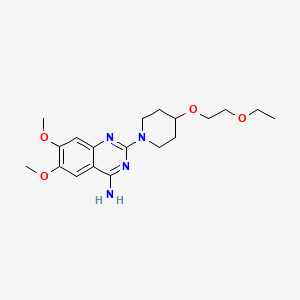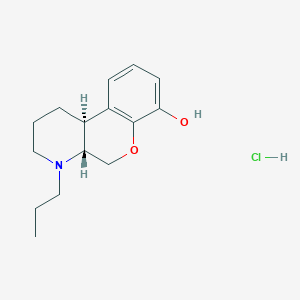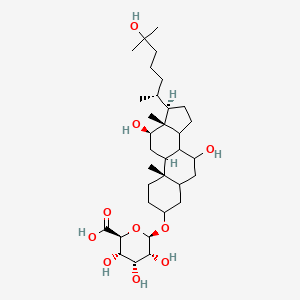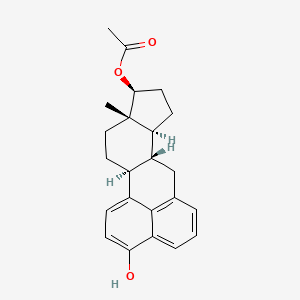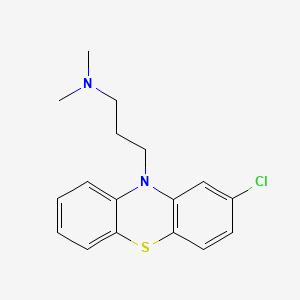
クロルプロマジン
概要
説明
Chlorpromazine is a synthetic tranquilizing drug that acts selectively upon the higher centers in the brain as a depressant of the central nervous system. It was first synthesized in 1950 and became widely available for medical use in the mid-1950s. Chlorpromazine is primarily used to treat psychotic disorders such as schizophrenia, bipolar disorder, severe behavioral problems in children, nausea, vomiting, anxiety before surgery, and intractable hiccups .
作用機序
Target of Action
Chlorpromazine primarily targets dopamine D2 receptors . These receptors play a crucial role in the dopaminergic transmission within the four dopaminergic pathways . In addition to dopamine receptors, chlorpromazine also inhibits serotonin (5-HT), muscarinic, and α1-adrenergic receptors .
科学的研究の応用
Chlorpromazine has a wide range of applications in scientific research:
Chemistry: Used as a model compound in studies of phenothiazine derivatives.
Biology: Investigated for its effects on cellular processes and enzyme activities.
Medicine: Extensively used in the treatment of psychiatric disorders. .
Industry: Utilized in the formulation of various pharmaceutical products.
生化学分析
Biochemical Properties
Chlorpromazine plays a significant role in biochemical reactions by interacting with various enzymes, proteins, and other biomolecules. It primarily acts as a dopamine antagonist, blocking dopamine receptors in the brain, which is believed to be the primary mechanism behind its antipsychotic effects . Additionally, chlorpromazine interacts with serotonin and histamine receptors, contributing to its sedative and antiemetic properties . The compound’s interactions with these receptors involve competitive inhibition, where chlorpromazine binds to the receptor sites, preventing the natural ligands from activating them .
Cellular Effects
Chlorpromazine affects various types of cells and cellular processes. It influences cell function by altering cell signaling pathways, gene expression, and cellular metabolism. In neuronal cells, chlorpromazine’s antagonistic action on dopamine receptors disrupts the normal signaling pathways, leading to reduced psychotic symptoms . It also affects gene expression by modulating the transcription of genes involved in neurotransmitter synthesis and receptor regulation . Furthermore, chlorpromazine impacts cellular metabolism by inhibiting enzymes involved in metabolic pathways, leading to altered energy production and utilization .
Molecular Mechanism
At the molecular level, chlorpromazine exerts its effects through several mechanisms. It binds to dopamine receptors, particularly the D2 subtype, blocking dopamine’s action and reducing psychotic symptoms . Chlorpromazine also exhibits strong alpha-adrenergic blocking effects, which contribute to its sedative properties . Additionally, it inhibits the release of hypothalamic and hypophyseal hormones, affecting basal metabolism, body temperature, wakefulness, vasomotor tone, and emesis . These interactions involve competitive inhibition and receptor blockade, leading to changes in neurotransmitter activity and hormonal regulation .
Temporal Effects in Laboratory Settings
In laboratory settings, the effects of chlorpromazine change over time. The compound’s stability and degradation are influenced by factors such as temperature, pH, and light exposure . Long-term studies have shown that chlorpromazine can cause persistent changes in cellular function, including alterations in neurotransmitter receptor density and gene expression . These effects are observed in both in vitro and in vivo studies, highlighting the importance of considering temporal factors when evaluating chlorpromazine’s impact on cellular processes .
Dosage Effects in Animal Models
The effects of chlorpromazine vary with different dosages in animal models. At low doses, chlorpromazine exhibits sedative and antiemetic effects, while higher doses can lead to significant adverse effects . In animal studies, high doses of chlorpromazine have been associated with hepatotoxicity, orthostatic hypotension, and leukopenia . These toxic effects highlight the importance of careful dosage management to avoid adverse outcomes in clinical settings .
Metabolic Pathways
Chlorpromazine is extensively metabolized in the liver through various pathways, including 7-hydroxylation, N-dealkylation, N-oxidation, and S-oxidation . The primary enzyme involved in these metabolic processes is cytochrome P450 isoenzyme 1A2 . The metabolic pathways result in the formation of numerous metabolites with varying pharmacological profiles and half-lives . These metabolites can further undergo conjugation reactions, leading to their excretion from the body .
Transport and Distribution
Chlorpromazine is transported and distributed within cells and tissues through various mechanisms. It is highly lipid-soluble and protein-bound, allowing it to cross cell membranes and accumulate in tissues . The compound is primarily distributed to the brain, liver, and kidneys, where it exerts its pharmacological effects . Transporters and binding proteins, such as albumin, play a crucial role in chlorpromazine’s distribution and localization within the body .
Subcellular Localization
Chlorpromazine’s subcellular localization affects its activity and function. The compound is known to perturb the subcellular localization of mutated receptor tyrosine kinases, such as FLT3-ITD and KIT-D816V, in acute myeloid leukemia cells . This perturbation leads to the inhibition of signaling pathways involved in cancer cell growth and survival . Chlorpromazine’s ability to alter the localization of these receptors highlights its potential as a therapeutic agent in cancer treatment .
準備方法
Synthetic Routes and Reaction Conditions: Chlorpromazine is synthesized through a multi-step process. The synthesis begins with the reaction of 2-chlorophenothiazine with 3-dimethylaminopropyl chloride in the presence of a base. The reaction proceeds through nucleophilic substitution, forming chlorpromazine .
Industrial Production Methods: In industrial settings, chlorpromazine is produced using similar synthetic routes but on a larger scale. The process involves strict control of reaction conditions such as temperature, pressure, and pH to ensure high yield and purity. The final product is often purified through recrystallization or chromatography .
化学反応の分析
Types of Reactions: Chlorpromazine undergoes various chemical reactions, including oxidation, reduction, and substitution.
Common Reagents and Conditions:
Oxidation: Chlorpromazine can be oxidized by metal cations such as iron or cerium, concentrated acids, or through electrolysis.
Reduction: Reduction of chlorpromazine can be achieved using reducing agents like sodium borohydride.
Substitution: Nucleophilic substitution reactions can occur, especially in the presence of strong bases.
Major Products:
Oxidation Products: Phenols, sulfoxides, and diphenol sulfoxides.
Reduction Products: Reduced forms of chlorpromazine.
Substitution Products: Various substituted phenothiazines.
類似化合物との比較
- Promazine
- Triflupromazine
- Trifluoperazine
- Haloperidol
- Fluphenazine
Chlorpromazine’s uniqueness lies in its extensive use and historical significance as the first antipsychotic medication introduced into clinical practice .
特性
IUPAC Name |
3-(2-chlorophenothiazin-10-yl)-N,N-dimethylpropan-1-amine | |
|---|---|---|
| Source | PubChem | |
| URL | https://pubchem.ncbi.nlm.nih.gov | |
| Description | Data deposited in or computed by PubChem | |
InChI |
InChI=1S/C17H19ClN2S/c1-19(2)10-5-11-20-14-6-3-4-7-16(14)21-17-9-8-13(18)12-15(17)20/h3-4,6-9,12H,5,10-11H2,1-2H3 | |
| Source | PubChem | |
| URL | https://pubchem.ncbi.nlm.nih.gov | |
| Description | Data deposited in or computed by PubChem | |
InChI Key |
ZPEIMTDSQAKGNT-UHFFFAOYSA-N | |
| Source | PubChem | |
| URL | https://pubchem.ncbi.nlm.nih.gov | |
| Description | Data deposited in or computed by PubChem | |
Canonical SMILES |
CN(C)CCCN1C2=CC=CC=C2SC3=C1C=C(C=C3)Cl | |
| Source | PubChem | |
| URL | https://pubchem.ncbi.nlm.nih.gov | |
| Description | Data deposited in or computed by PubChem | |
Molecular Formula |
C17H19ClN2S | |
| Source | PubChem | |
| URL | https://pubchem.ncbi.nlm.nih.gov | |
| Description | Data deposited in or computed by PubChem | |
DSSTOX Substance ID |
DTXSID0022808 | |
| Record name | Chlorpromazine | |
| Source | EPA DSSTox | |
| URL | https://comptox.epa.gov/dashboard/DTXSID0022808 | |
| Description | DSSTox provides a high quality public chemistry resource for supporting improved predictive toxicology. | |
Molecular Weight |
318.9 g/mol | |
| Source | PubChem | |
| URL | https://pubchem.ncbi.nlm.nih.gov | |
| Description | Data deposited in or computed by PubChem | |
Physical Description |
Solid | |
| Record name | Chlorpromazine | |
| Source | Human Metabolome Database (HMDB) | |
| URL | http://www.hmdb.ca/metabolites/HMDB0014620 | |
| Description | The Human Metabolome Database (HMDB) is a freely available electronic database containing detailed information about small molecule metabolites found in the human body. | |
| Explanation | HMDB is offered to the public as a freely available resource. Use and re-distribution of the data, in whole or in part, for commercial purposes requires explicit permission of the authors and explicit acknowledgment of the source material (HMDB) and the original publication (see the HMDB citing page). We ask that users who download significant portions of the database cite the HMDB paper in any resulting publications. | |
Boiling Point |
200-205 °C at 8.00E-01 mm Hg, BP: 200-205 °C at 0.8 mm Hg | |
| Record name | Chlorpromazine | |
| Source | DrugBank | |
| URL | https://www.drugbank.ca/drugs/DB00477 | |
| Description | The DrugBank database is a unique bioinformatics and cheminformatics resource that combines detailed drug (i.e. chemical, pharmacological and pharmaceutical) data with comprehensive drug target (i.e. sequence, structure, and pathway) information. | |
| Explanation | Creative Common's Attribution-NonCommercial 4.0 International License (http://creativecommons.org/licenses/by-nc/4.0/legalcode) | |
| Record name | Chlorpromazine | |
| Source | Hazardous Substances Data Bank (HSDB) | |
| URL | https://pubchem.ncbi.nlm.nih.gov/source/hsdb/3033 | |
| Description | The Hazardous Substances Data Bank (HSDB) is a toxicology database that focuses on the toxicology of potentially hazardous chemicals. It provides information on human exposure, industrial hygiene, emergency handling procedures, environmental fate, regulatory requirements, nanomaterials, and related areas. The information in HSDB has been assessed by a Scientific Review Panel. | |
Solubility |
Very soluble in ethanol, ether, benzene and chloroform; soluble in dilute hydrochloric acid, In water, 2.55X10-3 g/L (2.55 mg/L) at 24 °C, 4.17e-03 g/L | |
| Record name | Chlorpromazine | |
| Source | DrugBank | |
| URL | https://www.drugbank.ca/drugs/DB00477 | |
| Description | The DrugBank database is a unique bioinformatics and cheminformatics resource that combines detailed drug (i.e. chemical, pharmacological and pharmaceutical) data with comprehensive drug target (i.e. sequence, structure, and pathway) information. | |
| Explanation | Creative Common's Attribution-NonCommercial 4.0 International License (http://creativecommons.org/licenses/by-nc/4.0/legalcode) | |
| Record name | Chlorpromazine | |
| Source | Hazardous Substances Data Bank (HSDB) | |
| URL | https://pubchem.ncbi.nlm.nih.gov/source/hsdb/3033 | |
| Description | The Hazardous Substances Data Bank (HSDB) is a toxicology database that focuses on the toxicology of potentially hazardous chemicals. It provides information on human exposure, industrial hygiene, emergency handling procedures, environmental fate, regulatory requirements, nanomaterials, and related areas. The information in HSDB has been assessed by a Scientific Review Panel. | |
| Record name | Chlorpromazine | |
| Source | Human Metabolome Database (HMDB) | |
| URL | http://www.hmdb.ca/metabolites/HMDB0014620 | |
| Description | The Human Metabolome Database (HMDB) is a freely available electronic database containing detailed information about small molecule metabolites found in the human body. | |
| Explanation | HMDB is offered to the public as a freely available resource. Use and re-distribution of the data, in whole or in part, for commercial purposes requires explicit permission of the authors and explicit acknowledgment of the source material (HMDB) and the original publication (see the HMDB citing page). We ask that users who download significant portions of the database cite the HMDB paper in any resulting publications. | |
Mechanism of Action |
Chlorpromazine acts as an antagonist (blocking agent) on different postsysnaptic receptors -on dopaminergic-receptors (subtypes D1, D2, D3 and D4 - different antipsychotic properties on productive and unproductive symptoms), on serotonergic-receptors (5-HT1 and 5-HT2, with anxiolytic, antidepressive and antiaggressive properties as well as an attenuation of extrapypramidal side-effects, but also leading to weight gain, fall in blood pressure, sedation and ejaculation difficulties), on histaminergic-receptors (H1-receptors, sedation, antiemesis, vertigo, fall in blood pressure and weight gain), alpha1/alpha2-receptors (antisympathomimetic properties, lowering of blood pressure, reflex tachycardia, vertigo, sedation, hypersalivation and incontinence as well as sexual dysfunction, but may also attenuate pseudoparkinsonism - controversial) and finally on muscarinic (cholinergic) M1/M2-receptors (causing anticholinergic symptoms like dry mouth, blurred vision, obstipation, difficulty/inability to urinate, sinus tachycardia, ECG-changes and loss of memory, but the anticholinergic action may attenuate extrapyramidal side-effects). Additionally, Chlorpromazine is a weak presynaptic inhibitor of Dopamine reuptake, which may lead to (mild) antidepressive and antiparkinsonian effects. This action could also account for psychomotor agitation and amplification of psychosis (very rarely noted in clinical use)., The principal pharmacologic effects of chlorpromazine are similar to those of other propylamino derivatives of phenothiazine. Chlorpromazine has strong anticholinergic and sedative effects and moderate extrapyramidal effects. Chlorpromazine has strong antiemetic and adrenergic blocking activity and weak ganglionic blocking, antihistaminic, and antiserotonergic activity., The development of phenothiazine derivatives as psychopharmacologic agents resulted from the observation that certain phenothiazine antihistaminic compounds produced sedation. In an attempt to enhance the sedative effects of these drugs, promethazine and chlorpromazine were synthesized. Chlorpromazine is the pharmacologic prototype of the phenothiazines. The pharmacology of phenothiazines is complex, and because of their actions on the central and autonomic nervous systems, the drugs affect many different sites in the body. Although the actions of the various phenothiazines are generally similar, these drugs differ both quantitatively and qualitatively in the extent to which they produce specific pharmacologic effects. /Phenothiazine General Statement/, In the CNS, phenothiazines act principally at the subcortical levels of the reticular formation, limbic system, and hypothalamus. Phenothiazines generally do not produce substantial cortical depression; however, there is minimal information on the specific effects of phenothiazines at the cortical level. Phenothiazines also act in the basal ganglia, exhibiting extrapyramidal effects. The precise mechanism(s) of action, including antipsychotic action, of phenothiazines has not been determined, but may be principally related to antidopaminergic effects of the drugs. There is evidence to indicate that phenothiazines antagonize dopamine-mediated neurotransmission at the synapses. There is also some evidence that phenothiazines may block postsynaptic dopamine receptor sites. However, it has not been determined whether the antipsychotic effect of the drugs is causally related to their antidopaminergic effects. Phenothiazines also have peripheral and/or central antagonistic activity against alpha-adrenergic, serotonergic, histaminic (H1-receptors), and muscarinic receptors. Phenothiazines also have some adrenergic activity, since they block the reuptake of monoamines at the presynaptic neuronal membrane, which tends to enhance neurotransmission. The effects of phenothiazines on the autonomic nervous system are complex and unpredictable because the drugs exhibit varying degrees of alpha-adrenergic blocking, muscarinic blocking, and adrenergic activity. The antipsychotic activity of phenothiazines may be related to any or all of these effects, but it has been suggested that the drugs' effects on dopamine are probably most important. It has also been suggested that effects of phenothiazines on other amines (eg, gamma-aminobutyric acid [GABA]) or peptides (eg, substance P, endorphins) may contribute to their antipsychotic effect. Further study is needed to determine the role of central neuronal receptor antagonism and of effects on biochemical mediators in the antipsychotic action of the phenothiazines and other antipsychotic agents. /Phenothiazine General Statement/, Although the exact mechanism(s) of action has not been conclusively determined, phenothiazines have an antiemetic effect. The antiemetic activity may be mediated via a direct effect of the drugs on the medullary chemoreceptor trigger zone (CTZ), apparently by blocking dopamine receptors in the CTZ. Phenothiazines inhibit the central and peripheral effects of apomorphine and ergot alkaloids. Phenothiazines generally do not inhibit emesis caused by the action of drugs at the nodose ganglion or by local action on the GI tract. /Phenothiazine General Statement/, For more Mechanism of Action (Complete) data for Chlorpromazine (19 total), please visit the HSDB record page. | |
| Record name | Chlorpromazine | |
| Source | DrugBank | |
| URL | https://www.drugbank.ca/drugs/DB00477 | |
| Description | The DrugBank database is a unique bioinformatics and cheminformatics resource that combines detailed drug (i.e. chemical, pharmacological and pharmaceutical) data with comprehensive drug target (i.e. sequence, structure, and pathway) information. | |
| Explanation | Creative Common's Attribution-NonCommercial 4.0 International License (http://creativecommons.org/licenses/by-nc/4.0/legalcode) | |
| Record name | Chlorpromazine | |
| Source | Hazardous Substances Data Bank (HSDB) | |
| URL | https://pubchem.ncbi.nlm.nih.gov/source/hsdb/3033 | |
| Description | The Hazardous Substances Data Bank (HSDB) is a toxicology database that focuses on the toxicology of potentially hazardous chemicals. It provides information on human exposure, industrial hygiene, emergency handling procedures, environmental fate, regulatory requirements, nanomaterials, and related areas. The information in HSDB has been assessed by a Scientific Review Panel. | |
Color/Form |
Oily liquid, White, crystalline solid | |
CAS No. |
34468-21-8, 50-53-3 | |
| Record name | 10H-Phenothiazine-10-propanamine, 2-chloro-N,N-dimethyl-, radical ion(1+) | |
| Source | CAS Common Chemistry | |
| URL | https://commonchemistry.cas.org/detail?cas_rn=34468-21-8 | |
| Description | CAS Common Chemistry is an open community resource for accessing chemical information. Nearly 500,000 chemical substances from CAS REGISTRY cover areas of community interest, including common and frequently regulated chemicals, and those relevant to high school and undergraduate chemistry classes. This chemical information, curated by our expert scientists, is provided in alignment with our mission as a division of the American Chemical Society. | |
| Explanation | The data from CAS Common Chemistry is provided under a CC-BY-NC 4.0 license, unless otherwise stated. | |
| Record name | Chlorpromazine | |
| Source | CAS Common Chemistry | |
| URL | https://commonchemistry.cas.org/detail?cas_rn=50-53-3 | |
| Description | CAS Common Chemistry is an open community resource for accessing chemical information. Nearly 500,000 chemical substances from CAS REGISTRY cover areas of community interest, including common and frequently regulated chemicals, and those relevant to high school and undergraduate chemistry classes. This chemical information, curated by our expert scientists, is provided in alignment with our mission as a division of the American Chemical Society. | |
| Explanation | The data from CAS Common Chemistry is provided under a CC-BY-NC 4.0 license, unless otherwise stated. | |
| Record name | Chlorpromazine [USP:INN:BAN] | |
| Source | ChemIDplus | |
| URL | https://pubchem.ncbi.nlm.nih.gov/substance/?source=chemidplus&sourceid=0000050533 | |
| Description | ChemIDplus is a free, web search system that provides access to the structure and nomenclature authority files used for the identification of chemical substances cited in National Library of Medicine (NLM) databases, including the TOXNET system. | |
| Record name | Chlorpromazine cation radical | |
| Source | ChemIDplus | |
| URL | https://pubchem.ncbi.nlm.nih.gov/substance/?source=chemidplus&sourceid=0034468218 | |
| Description | ChemIDplus is a free, web search system that provides access to the structure and nomenclature authority files used for the identification of chemical substances cited in National Library of Medicine (NLM) databases, including the TOXNET system. | |
| Record name | Chlorpromazine | |
| Source | DrugBank | |
| URL | https://www.drugbank.ca/drugs/DB00477 | |
| Description | The DrugBank database is a unique bioinformatics and cheminformatics resource that combines detailed drug (i.e. chemical, pharmacological and pharmaceutical) data with comprehensive drug target (i.e. sequence, structure, and pathway) information. | |
| Explanation | Creative Common's Attribution-NonCommercial 4.0 International License (http://creativecommons.org/licenses/by-nc/4.0/legalcode) | |
| Record name | chlorpromazine | |
| Source | DTP/NCI | |
| URL | https://dtp.cancer.gov/dtpstandard/servlet/dwindex?searchtype=NSC&outputformat=html&searchlist=756689 | |
| Description | The NCI Development Therapeutics Program (DTP) provides services and resources to the academic and private-sector research communities worldwide to facilitate the discovery and development of new cancer therapeutic agents. | |
| Explanation | Unless otherwise indicated, all text within NCI products is free of copyright and may be reused without our permission. Credit the National Cancer Institute as the source. | |
| Record name | chlorpromazine | |
| Source | DTP/NCI | |
| URL | https://dtp.cancer.gov/dtpstandard/servlet/dwindex?searchtype=NSC&outputformat=html&searchlist=167745 | |
| Description | The NCI Development Therapeutics Program (DTP) provides services and resources to the academic and private-sector research communities worldwide to facilitate the discovery and development of new cancer therapeutic agents. | |
| Explanation | Unless otherwise indicated, all text within NCI products is free of copyright and may be reused without our permission. Credit the National Cancer Institute as the source. | |
| Record name | Chlorpromazine | |
| Source | EPA DSSTox | |
| URL | https://comptox.epa.gov/dashboard/DTXSID0022808 | |
| Description | DSSTox provides a high quality public chemistry resource for supporting improved predictive toxicology. | |
| Record name | Chlorpromazine | |
| Source | European Chemicals Agency (ECHA) | |
| URL | https://echa.europa.eu/substance-information/-/substanceinfo/100.000.042 | |
| Description | The European Chemicals Agency (ECHA) is an agency of the European Union which is the driving force among regulatory authorities in implementing the EU's groundbreaking chemicals legislation for the benefit of human health and the environment as well as for innovation and competitiveness. | |
| Explanation | Use of the information, documents and data from the ECHA website is subject to the terms and conditions of this Legal Notice, and subject to other binding limitations provided for under applicable law, the information, documents and data made available on the ECHA website may be reproduced, distributed and/or used, totally or in part, for non-commercial purposes provided that ECHA is acknowledged as the source: "Source: European Chemicals Agency, http://echa.europa.eu/". Such acknowledgement must be included in each copy of the material. ECHA permits and encourages organisations and individuals to create links to the ECHA website under the following cumulative conditions: Links can only be made to webpages that provide a link to the Legal Notice page. | |
| Record name | CHLORPROMAZINE | |
| Source | FDA Global Substance Registration System (GSRS) | |
| URL | https://gsrs.ncats.nih.gov/ginas/app/beta/substances/U42B7VYA4P | |
| Description | The FDA Global Substance Registration System (GSRS) enables the efficient and accurate exchange of information on what substances are in regulated products. Instead of relying on names, which vary across regulatory domains, countries, and regions, the GSRS knowledge base makes it possible for substances to be defined by standardized, scientific descriptions. | |
| Explanation | Unless otherwise noted, the contents of the FDA website (www.fda.gov), both text and graphics, are not copyrighted. They are in the public domain and may be republished, reprinted and otherwise used freely by anyone without the need to obtain permission from FDA. Credit to the U.S. Food and Drug Administration as the source is appreciated but not required. | |
| Record name | Chlorpromazine | |
| Source | Hazardous Substances Data Bank (HSDB) | |
| URL | https://pubchem.ncbi.nlm.nih.gov/source/hsdb/3033 | |
| Description | The Hazardous Substances Data Bank (HSDB) is a toxicology database that focuses on the toxicology of potentially hazardous chemicals. It provides information on human exposure, industrial hygiene, emergency handling procedures, environmental fate, regulatory requirements, nanomaterials, and related areas. The information in HSDB has been assessed by a Scientific Review Panel. | |
| Record name | Chlorpromazine | |
| Source | Human Metabolome Database (HMDB) | |
| URL | http://www.hmdb.ca/metabolites/HMDB0014620 | |
| Description | The Human Metabolome Database (HMDB) is a freely available electronic database containing detailed information about small molecule metabolites found in the human body. | |
| Explanation | HMDB is offered to the public as a freely available resource. Use and re-distribution of the data, in whole or in part, for commercial purposes requires explicit permission of the authors and explicit acknowledgment of the source material (HMDB) and the original publication (see the HMDB citing page). We ask that users who download significant portions of the database cite the HMDB paper in any resulting publications. | |
Melting Point |
177-178, About 60 °C, < 25 °C | |
| Record name | Chlorpromazine | |
| Source | DrugBank | |
| URL | https://www.drugbank.ca/drugs/DB00477 | |
| Description | The DrugBank database is a unique bioinformatics and cheminformatics resource that combines detailed drug (i.e. chemical, pharmacological and pharmaceutical) data with comprehensive drug target (i.e. sequence, structure, and pathway) information. | |
| Explanation | Creative Common's Attribution-NonCommercial 4.0 International License (http://creativecommons.org/licenses/by-nc/4.0/legalcode) | |
| Record name | Chlorpromazine | |
| Source | Hazardous Substances Data Bank (HSDB) | |
| URL | https://pubchem.ncbi.nlm.nih.gov/source/hsdb/3033 | |
| Description | The Hazardous Substances Data Bank (HSDB) is a toxicology database that focuses on the toxicology of potentially hazardous chemicals. It provides information on human exposure, industrial hygiene, emergency handling procedures, environmental fate, regulatory requirements, nanomaterials, and related areas. The information in HSDB has been assessed by a Scientific Review Panel. | |
| Record name | Chlorpromazine | |
| Source | Human Metabolome Database (HMDB) | |
| URL | http://www.hmdb.ca/metabolites/HMDB0014620 | |
| Description | The Human Metabolome Database (HMDB) is a freely available electronic database containing detailed information about small molecule metabolites found in the human body. | |
| Explanation | HMDB is offered to the public as a freely available resource. Use and re-distribution of the data, in whole or in part, for commercial purposes requires explicit permission of the authors and explicit acknowledgment of the source material (HMDB) and the original publication (see the HMDB citing page). We ask that users who download significant portions of the database cite the HMDB paper in any resulting publications. | |
Synthesis routes and methods I
Procedure details




Synthesis routes and methods II
Procedure details





Retrosynthesis Analysis
AI-Powered Synthesis Planning: Our tool employs the Template_relevance Pistachio, Template_relevance Bkms_metabolic, Template_relevance Pistachio_ringbreaker, Template_relevance Reaxys, Template_relevance Reaxys_biocatalysis model, leveraging a vast database of chemical reactions to predict feasible synthetic routes.
One-Step Synthesis Focus: Specifically designed for one-step synthesis, it provides concise and direct routes for your target compounds, streamlining the synthesis process.
Accurate Predictions: Utilizing the extensive PISTACHIO, BKMS_METABOLIC, PISTACHIO_RINGBREAKER, REAXYS, REAXYS_BIOCATALYSIS database, our tool offers high-accuracy predictions, reflecting the latest in chemical research and data.
Strategy Settings
| Precursor scoring | Relevance Heuristic |
|---|---|
| Min. plausibility | 0.01 |
| Model | Template_relevance |
| Template Set | Pistachio/Bkms_metabolic/Pistachio_ringbreaker/Reaxys/Reaxys_biocatalysis |
| Top-N result to add to graph | 6 |
Feasible Synthetic Routes
A: Chlorpromazine exerts its effects primarily through antagonism of α-adrenergic receptors and calcium antagonism. [] This dual mechanism contributes to its vasorelaxing properties. []
A: Chlorpromazine can inhibit calcium influx into cells, which is particularly relevant in excitable tissues like muscles and neurons. [] This inhibition of calcium influx can lead to decreased muscle contraction and reduced neuronal excitability. [, ]
A: Research suggests that Chlorpromazine can influence the levels of various neurotransmitters in the brain, including dopamine, serotonin, and their metabolites, in a strain-dependent manner in mice. [, ]
ANone: The molecular formula of Chlorpromazine hydrochloride is C17H19ClN2S·HCl, and its molecular weight is 355.33 g/mol.
A: Yes, Chlorpromazine exhibits strong interactions with lipid bilayers of various compositions, leading to increased membrane permeability. [] This property might contribute to its ability to enhance the cytotoxic effect of other drugs like Tamoxifen. []
ANone: Based on the provided research papers, there is no evidence to suggest that Chlorpromazine possesses catalytic properties or is used in catalytic applications.
A: Comparing Chlorpromazine with its non-chlorinated analog, promazine, reveals that the chlorine atom contributes to Chlorpromazine's higher potency in accelerating state 4 respiration in isolated rat liver mitochondria. [] This difference suggests the chlorine atom plays a role in Chlorpromazine's interaction with mitochondrial membranes.
ANone: The provided research papers do not offer specific details on Chlorpromazine's stability under various conditions or formulation strategies to enhance its properties.
A: Studies in rats revealed that 40-50% of a Chlorpromazine dose is excreted in urine and an equivalent amount in feces. [] The main excretion products identified include Chlorpromazine itself, Chlorpromazine sulfoxide, and its secondary and primary amine metabolites. []
A: Research indicates that plasma disappearance rates of Chlorpromazine are similar in patients with compensated cirrhosis and healthy individuals, suggesting no significant impairment of hepatic metabolism in this patient population. []
A: High-protein meals can decrease the peak plasma concentration (ρmax), area under the curve from 0 to t (AUC0→t), and AUC from 0 to infinity (AUC0→∞) of Chlorpromazine. []
A: In vitro studies demonstrate that Chlorpromazine acts synergistically with Tamoxifen to reduce cell growth and metabolic activity in both Tamoxifen-sensitive (MCF-7) and Tamoxifen-resistant breast cancer cell lines. []
A: Pretreatment with Chlorpromazine (20 mg/kg) 30 minutes before inducing ischemia in a rat model significantly protected against ischemic liver cell death, likely due to its ability to reduce calcium overload in liver cells and improve ATP regeneration. []
ANone: Addressing toxicology and safety is outside the scope of this scientific Q&A. For such information, please refer to the prescribing information and relevant safety databases.
A: Several methods are available for Chlorpromazine quantification, including: * Gas-liquid chromatography (GLC): Offers high sensitivity for measuring Chlorpromazine in plasma. [] * High-performance liquid chromatography (HPLC): A versatile technique used for simultaneous determination of Chlorpromazine and other drugs in biological samples. [, ] * Spectrophotometry: A simple and rapid method for Chlorpromazine determination in raw material powder based on its oxidation with sodium periodate. []
試験管内研究製品の免責事項と情報
BenchChemで提示されるすべての記事および製品情報は、情報提供を目的としています。BenchChemで購入可能な製品は、生体外研究のために特別に設計されています。生体外研究は、ラテン語の "in glass" に由来し、生物体の外で行われる実験を指します。これらの製品は医薬品または薬として分類されておらず、FDAから任何の医療状態、病気、または疾患の予防、治療、または治癒のために承認されていません。これらの製品を人間または動物に体内に導入する形態は、法律により厳格に禁止されています。これらのガイドラインに従うことは、研究と実験において法的および倫理的な基準の遵守を確実にするために重要です。
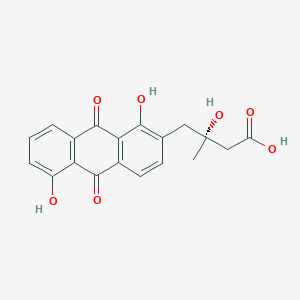
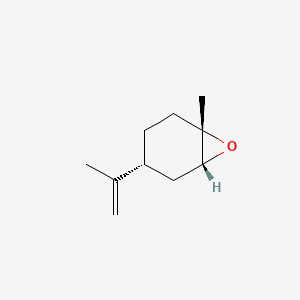
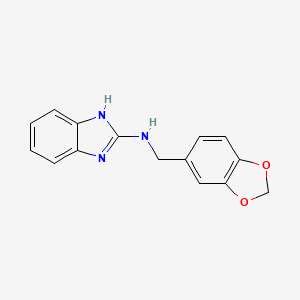

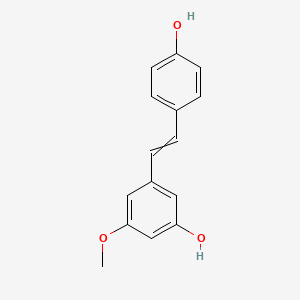
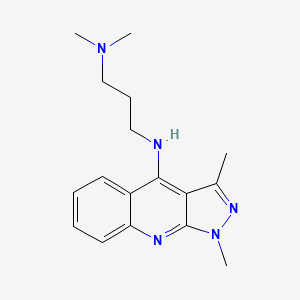

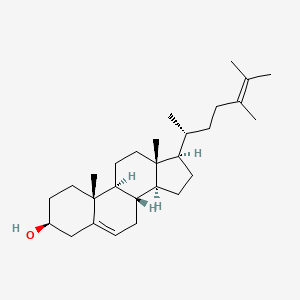
![Gal(b1-3)GlcNAc(b1-3)[Gal(b1-4)GlcNAc(b1-6)]Gal(b1-4)aldehydo-Glc](/img/structure/B1221266.png)

